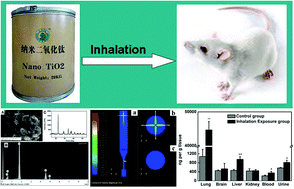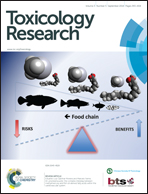Aerosol inhalation exposure study of respiratory toxicity induced by 20 nm anatase titanium dioxide nanoparticles†
Abstract
With the rapid development of nanoscience and nanotechnology, comprehensive evaluation of the potential toxicity especially the respiratory toxicity of nanomaterials, has attracted great research interest over the past few decades. A numerous previous reports have utilized intratracheal instillation to imitate the physiological inhalation exposure route of nanomaterials. However, because it is a non-physiological breathing process, intratracheal instillation has many problems when it is utilized to evaluate respiratory toxicity of nanomaterials. In this study, anatase titanium dioxide (TiO2) nanoparticles with a primary particle size of 20 nm was selected as a model nanomaterial. Its respiratory toxicity has been estimated by a whole-body exposure chamber. Mice were put in the whole-body exposure chambers with a relatively steady concentration (6.34 ± 0.22 mg m−3) of inhaled TiO2 nanoparticles. In the whole study these mice were exposed 8 h per day, for 3 weeks. Results showed that these TiO2 nanoparticles inhaled might drill through air–blood barriers, be metabolized by the liver and excreted by the urinary system. After mice had been exposed to TiO2 nanoparticles, H2O2 and maleic dialdehyde (MDA) in brain homogenate extracts had clearly increased. The white blood cell (WBC) count was decreased while platelet (PLT) and reticulocyte (Retic) counts increased significantly. At the same time, the prothrombin time (PT) of mice in the inhalation exposure group was shorter than the control group's. Furthermore, compared with the control group's, the levels of ALT, AST, BUN and CREA in the inhalation exposure group were elevated. Given the whole body exposure method is a physiological exposure route, the results reported in this work should be more suitable for evaluation of the respiratory toxicity of nanomaterials.


 Please wait while we load your content...
Please wait while we load your content...